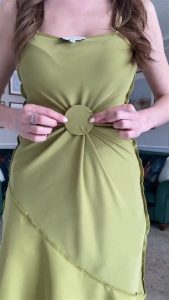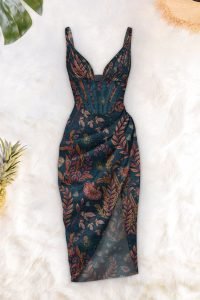Does a beloved dress hang forgotten in your closet because it feels a tad too snug? Don’t relegate it to the back just yet! There are several clever ways to stretch out a dress, giving it a new lease on life and saving you money on a new outfit.
Assess the Dress
Before diving into stretching techniques, take a moment to assess the dress. Consider the following:
Material:
Different fabrics respond differently to stretching. Fabrics with natural fibers like cotton or linen may be more forgiving than synthetics like polyester.
Tightness:
How snug is the dress? A slight tightness might be addressed with simple techniques, while a significantly constricting dress might require a different approach.
Natural Conditioning Treatments
Certain household items can be used to gently stretch and soften fabrics. Here are a few methods to try, but always test on a small, inconspicuous area of the dress first:
-
Vinegar and Water Soak: Mix equal parts white vinegar and cool water in a basin. Submerge the dress for 30 minutes to an hour, then rinse thoroughly with cool water and lay flat to dry. Vinegar can help loosen fabric fibers.
-
Conditioner Soak: Fill a basin with cool water and add a generous amount of hair conditioner. Let the dress soak for 30 minutes to an hour, then rinse thoroughly with cool water and lay flat to dry. Conditioner can soften and relax fabric fibers.

Strategic Hanging
The power of gravity can work wonders! Here’s how to use it to your advantage:
-
Wet Hanging: After washing the dress, hang it wet on a sturdy hanger. The weight of the water can gently stretch the fabric as it dries. Ensure the hanger is the right size for the dress to prevent misshaping the shoulders.
-
Steam Hanging: Steam the dress while hanging on a sturdy hanger. The heat and moisture combination can help loosen fabric fibers. Be mindful of the fabric care instructions and avoid using excessive heat that could damage the dress.
Creative Techniques
For more targeted stretching, consider these techniques:
-
Strategic Spot Stretches: For specific areas like the arms or shoulders, gently pull and stretch the fabric while it’s damp. Be mindful not to pull too forcefully, and avoid stretching seams.
-
Insert Panels: If the tightness is concentrated in a specific area, consider adding a strategically placed panel of a complementary fabric. This can add a design element while increasing the dress’s size.

Prevention is Key
To avoid future wardrobe woes, consider these tips when purchasing new clothes:
-
Try Before You Buy: Whenever possible, try on clothes before buying them. This ensures a good fit and avoids the need for stretching later.
-
Invest in Quality Fabrics: Dresses made with natural fibers with a slight give tend to retain their shape better over time.
Giving new life to a beloved dress is a sustainable fashion choice. It reduces clothing waste and allows you to continue rocking a garment you love. So get creative, have fun, and breathe new life into your wardrobe!
Tailoring for a Perfect Fit
Sometimes, even after trying on clothes, a dress might need a little adjustment for a perfect fit. Here’s where tailoring comes in! Tailoring involves modifying a garment to better suit your body shape. It’s a great way to breathe new life into a dress that might be slightly snug or needs a touch of alteration.
Tailoring can address a variety of fit concerns:
-
Taking in Seams: A skilled tailor can take in seams at specific areas like the bodice or waist to create a more fitted silhouette.
-
Length Adjustments: The hem of a dress can be raised or lowered to achieve the desired length.
-
Adding Panels: As mentioned earlier, a tailor can strategically add panels of complementary fabric to areas that feel too tight. This can improve fit and comfort while adding a unique design element.

Finding a Tailor
Many dry cleaners offer tailoring services. You can also search online or ask friends for recommendations for local tailors. When choosing a tailor, consider their experience, reputation, and pricing.
Clear communication is key when working with a tailor. Be specific about the areas you want adjusted and the desired fit. Don’t hesitate to ask questions and ensure you’re comfortable with the proposed alterations before they proceed.
Sustainable Style Champion
By getting a dress tailored, you’re extending its lifespan and reducing clothing waste. This aligns perfectly with the concept of sustainable fashion! Tailoring allows you to continue rocking a garment you love while ensuring a perfect and comfortable fit.
The most important aspect of fashion is feeling confident and comfortable in what you wear. Whether you rock a dress straight off the rack, breathe new life into it with stretching techniques, or get it tailored to perfection, focus on feeling good and expressing your unique style!

Building a Sustainable Wardrobe
Tailoring and revamping clothes are fantastic ways to extend the life of your wardrobe, but there are other strategies for building a sustainable closet! Here are some tips:
-
Shop Secondhand: Thrift stores and consignment shops are treasure troves for unique and affordable clothing. You can find high-quality garments at a fraction of the retail price, reducing your environmental impact and supporting pre-loved clothing.
-
Invest in Quality Staples: Opt for classic, well-made pieces in neutral colors that can be easily mixed and matched. These versatile staples will form the foundation of your wardrobe and reduce the urge for trendy impulse buys.
-
Embrace Clothing Swaps: Organize clothing swaps with friends or participate in community swap events. It’s a fun way to refresh your wardrobe with new-to-you pieces without spending money or generating waste.
-
Prioritize Care: Taking proper care of your clothes extends their lifespan. Follow the care instructions on garment tags and invest in gentle detergents and stain removers.
The Power of DIY
Learning basic sewing skills opens doors to endless creative possibilities! Here are a few ideas:
-
Simple Repairs: Being able to mend a button, fix a small tear, or replace a hem can significantly extend the life of your clothes.
-
Upcycle Old Clothes: Transform old clothes into something new! Give an old t-shirt a new life by turning it into a tote bag or crop top. Upcycling is a fun and sustainable way to express your creativity.

